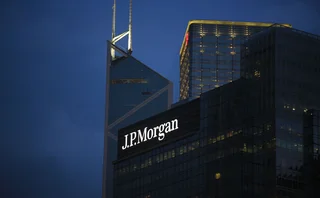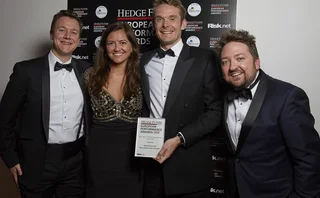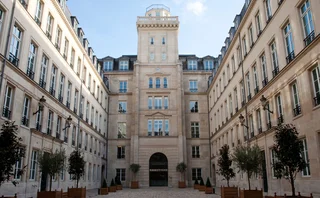
Specialist star still shining as suffering stocks set up strong sector growth
The volatile biotechnology industry looks set to take centre stage as the technology sector continues to perform
2004 should provide continued opportunities for technology hedge fund managers after a stellar environment for some specialist portfolios in 2003.
Georgios Bourtzos, principal at EWorld Fund Management, which runs the technology-focused EWorld Fund Limited, notes that year-end 2003 saw flat equity markets with only the Nasdaq up more than 1% in November.
Positive contributions to the fund in November were made by investments in telecom equipment, nanotechnology and generic drugs. The performance of Asian technology firms is shown in the accompanying graph.
The EWorld fund was positioned for inflows into the markets' small-cap segment towards the year's end and aims to profit from medium-term Nasdaq volatility and long-term technology stock growth by analysing macro-economic factors and price, money flows, volume, and short interest.
The fund will hedge a portion of its technology exposure with short positions on indices through exchange-traded funds and investments in negatively correlated equity sectors, such as precious metals.
Its investments have produced an annualised return from the portfolio of 37.14% between its 1999 inception and December 2003. This was helped by a healthy 61.76% return in 2003.
Another technology hedge fund displaying good returns in 2003 was FMG's Hi-Tech Hedge Fund – a fund of hedge funds which returned 13.35% through allocations to six underlying technology fund managers.
FMG is committed to single-sector, diversified hedge fund products, running a healthcare and biotech fund, complemented by funds focusing on China, Scandinavia, the US and India.
In January, the FMG Bio-Med Hedge Fund was aiming for its 16th consecutive positive month and was emphasising the biotechnology sector within healthcare, while also investing in pharmaceutical companies and medical devices and services companies.
"Biotech stocks normally show high levels of volatility. The Amex Biotech Index is down 50% from its peak in 2000 and the Pharma Index is down 30%," the group notes. "This should be a good buy opportunity in an industry with strong growth fundamentals, a large, fast-growing market due to favourable demographics, a high-margin industry with huge growth potential (and an) improving scientific and regulatory environment."
Arild Johansen, director of research at FMG Fund Management, says the underlying managers in FMG's pure technology fund had mainly allocated to US firms but keep a constant eye on Asia and Europe, where manufacture may be outsourced. For less-developed markets, Johansen says, the underlying managers would use US-listed ADRs.
He says the 2003 performance of the various underlying managers is largely a function of their respective levels of gross exposure, coupled with their stock-picking skills: "The managers who did not do well last year had low net exposures. Some were only up 10% or 12%, while others were up 50% to 60% because they took more net long exposures, (and were) perhaps more active in software, semi-conductors and voice over the internet protocol."
New York-based fund manager Patrick Manning with Quasar Capital was one of FMG's better performers in 2003, up almost 50%, says Johansen, and he provided "substantial gains" in 2001 and 2002 as well. "His macro calls have been right on and he will expose himself opportunistically long or short as well as having stock-specific skills."
Since FMG's technology fund's October 1999 inception, says the group, cumulative returns total 43%, against technology indices' 24% fall.
This is with fewer specialist technology managers to choose from, as some investors have removed money from this sector, Johansen says.
The FMG portfolio's standard deviation has been 15.48% since launch; below the S&P 500's 17.88% and the tech-benchmark Nasdaq Index's 37.55%. The fund's maximum drawdown has been 29.97% undershooting the S&P 500's 46.28% over the same period, and the Nasdaq 100's 75.04%.
The fund has moved from being in most of the larger tech hedge funds towards hedge funds across the size spectrum, with assets of $25m to $250m.
Key Points
Some technology funds benefited in November from telecom equipment, nanotechnology and generic drugs. Portfolios were positioned for inflows to small-caps toward year's end
Managers saw tech portfolios' net gross exposure as guiding returns.
However, stock selection was still important in generating returns
Only users who have a paid subscription or are part of a corporate subscription are able to print or copy content.
To access these options, along with all other subscription benefits, please contact info@risk.net or view our subscription options here: http://subscriptions.risk.net/subscribe
You are currently unable to print this content. Please contact info@risk.net to find out more.
You are currently unable to copy this content. Please contact info@risk.net to find out more.
Copyright Infopro Digital Limited. All rights reserved.
You may share this content using our article tools. Printing this content is for the sole use of the Authorised User (named subscriber), as outlined in our terms and conditions - https://www.infopro-insight.com/terms-conditions/insight-subscriptions/
If you would like to purchase additional rights please email info@risk.net
Copyright Infopro Digital Limited. All rights reserved.
You may share this content using our article tools. Copying this content is for the sole use of the Authorised User (named subscriber), as outlined in our terms and conditions - https://www.infopro-insight.com/terms-conditions/insight-subscriptions/
If you would like to purchase additional rights please email info@risk.net
More on Hedge funds
JP Morgan warns hedge funds to expect intraday margin calls
US bank may demand variation margin ‘up to seven’ times a day after Archegos default
Alternative markets give edge to Florin Court strategy
By concentrating on exotic and alternative markets, Florin Court Capital Fund has sidestepped overcrowding and correlation to the main trend following commodity trading advisers, offering investors a diversified alternative to the standard systemic macro…
Global macro views combine with quantitative models to produce consistent returns
The team behind River and Mercantile Group’s global macro strategy team operates under two key principles: that macro is the most important aspect of any investment decision and that decision-making should incorporate both systematic and discretionary…
On the offensive – Seeking a new edge, buy-side invests in portfolio and risk analytics
A fast-moving, headstrong hedge fund – hit by rare losses after a black swan event touched on an overweight country exposure – ponders adding fresh quantitative expertise. Much to traders’ chagrin, the chief investment officer and chief operating officer…
Esma backtracks on account segregation
Status quo protected for rehypothecation of collateral in tri-party, securities lending and prime brokerage
Redemptions focused within strategies suffering losses in 2016
Redemptions focused within strategies suffering losses in 2016
Hedge fund redemptions a dismal end to a bad year
Managed futures funds saw big inflows in 2016, but left investors disappointed
Larger funds are net losers as outflows continue
Managed futures funds have seen biggest redemptions for three years






